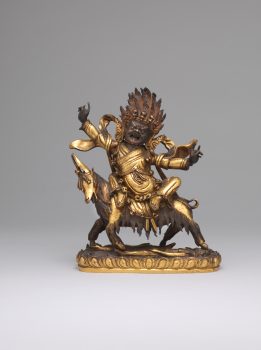China
ca. 18th century


China
ca. 18th century


Damchen Garwai Nakpo, the Blacksmith, was a local pre-Buddhist Tibetan deity subdued by the great master Padmasambhava (8th century), who was invited to Tibet by the king to introduce Esoteric Buddhism to the region. Padmasambhava converted the Blacksmith and other local deities by oath to protectors of the Buddhist teachings. Riding atop a shaggy goat, his upraised right hand once held a hammer and his outstretched left hand once held a blacksmith’s bellows. Cast separately, the two objects are now lost.This depiction has a particularly dynamic posture and lively continence. Details of the workmanship such as the contrasting patinas of the dark flesh and the gilding as well as the stylization of the skull ornaments on his crown and the garland around his neck suggest a Chinese manufacture.
A kind of energy that can be used, individually and collectively, to effect change.
A virtuous feeling and deep respect toward an authentic teaching, teacher, or path. Buddhists believe that expansive study, analysis, and meditation are essential steps for cultivating a healthy and enduring devotion.
Protectors of Buddhist teachings who destroy obstacles that impede the path to enlightenment. The more frightening and gruesome their appearance, the greater their power.
Although Tibetan Buddhism was not practiced broadly in China, the imperial centers, such as Beijing and Mount Wutai, emerged as hubs of Tibetan Buddhist cultural production. The emperors of the Mongol Yuan (1271–1368), Chinese Ming (1368–1644), and Manchu Qing (1644–1911) dynasties harnessed Tibetan Buddhist ideas to consolidate their power.
Get the latest news and stories from the Rubin, plus occasional information on how to support our work.